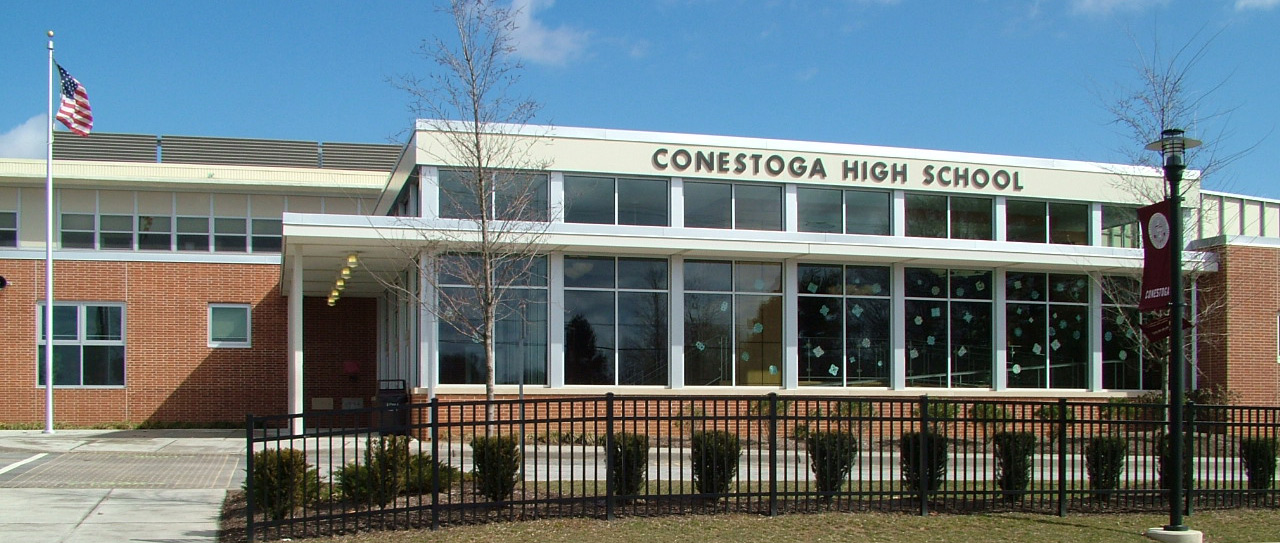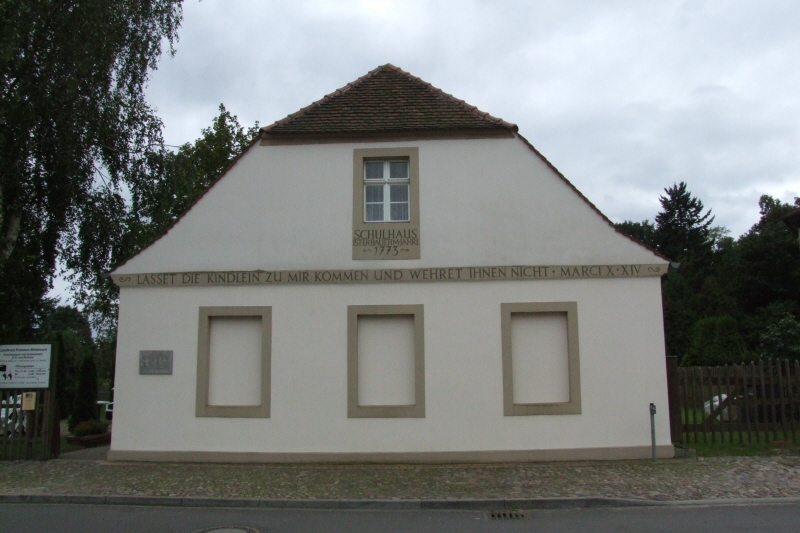|
Diamond Rock Schoolhouse
The Diamond Rock Schoolhouse is a historic octagonal one-room school located in Tredyffrin Township, Chester County, Pennsylvania. Constructed in 1818, the schoolhouse closed in 1864 and later served as a studio for Wharton Esherick. A local newspapers in 1940 described the schoolhouse as "one of the few remaining octagonal school buildings in Pennsylvania." Description and history Constructed in 1818 at a cost of $260.93 by predominantly Mennonite families of Welsh and German descent, the schoolhouse was designed as an octagon because the shape provided one wall and window for each of the six grades and another for the teacher facing the door, with a wood-burning stove in the center of the room. This design could accommodate 60 students at a time. The schoolhouse is twenty-six feet across at its widest point, and each of its eight walls is ten feet long. The schoolhouse closed in 1864 and reverted to the ownership of a local family. It fell into extreme disrepair until forme ... [...More Info...] [...Related Items...] OR: [Wikipedia] [Google] [Baidu] |
Tredyffrin Township, Pennsylvania
Tredyffrin Township ( ) is a township located in eastern Chester County, Pennsylvania. The population was 29,332 at the 2010 census. Settled in the late 17th century, Tredyffrin is bounded by Delaware and Montgomery counties. It includes on its northern boundary a small part of Valley Forge National Historical Park, where George Washington encamped during the American War of Independence. Tredyffrin and the entire Great Valley region also have many limestone deposits. Tredyffrin is the most populous township in Chester County. Unincorporated communities within Tredyffrin Township include Chesterbrook, Strafford, a portion of Paoli, and a portion of Wayne, Howellville (the intersection of Swedesford and Howellville Roads) and East Howellville (along Howellville Road, west of the intersection of Howellville Road and the border between Tredyffrin and Easttown Townships). Tredyffrin is bordered by Easttown, East Whiteland, Willistown, Charlestown, Upper Merion, Radnor ... [...More Info...] [...Related Items...] OR: [Wikipedia] [Google] [Baidu] |
Chester County, Pennsylvania
Chester County (Pennsylvania Dutch: ''Tscheschter Kaundi''), colloquially known as Chesco, is a county in the Commonwealth of Pennsylvania. It is located in the Delaware Valley region of the state. As of the 2020 census, the population was 534,413, increasing by 7.1% from 498,886 in 2010. The county seat and most populated municipality is West Chester. Chester County was one of the three original Pennsylvania counties created by William Penn in 1682. It was named for Chester, England. Chester County is part of the Philadelphia- Camden- Wilmington, PA- NJ- DE- MD Metropolitan Statistical Area. Eastern Chester County is home to many communities that comprise part of the Philadelphia Main Line western suburbs outside of Philadelphia, while part of its southernmost portion is considered suburban Wilmington, along with southwest Delaware County. History Philadelphia, Bucks, and Chester were the three Pennsylvania counties initially created by William Penn on August 24, 1682. ... [...More Info...] [...Related Items...] OR: [Wikipedia] [Google] [Baidu] |
Pennsylvania
Pennsylvania (; ( Pennsylvania Dutch: )), officially the Commonwealth of Pennsylvania, is a state spanning the Mid-Atlantic, Northeastern, Appalachian, and Great Lakes regions of the United States. It borders Delaware to its southeast, Maryland to its south, West Virginia to its southwest, Ohio to its west, Lake Erie and the Canadian province of Ontario to its northwest, New York to its north, and the Delaware River and New Jersey to its east. Pennsylvania is the fifth-most populous state in the nation with over 13 million residents as of 2020. It is the 33rd-largest state by area and ranks ninth among all states in population density. The southeastern Delaware Valley metropolitan area comprises and surrounds Philadelphia, the state's largest and nation's sixth most populous city. Another 2.37 million reside in Greater Pittsburgh in the southwest, centered around Pittsburgh, the state's second-largest and Western Pennsylvania's largest city. The state's su ... [...More Info...] [...Related Items...] OR: [Wikipedia] [Google] [Baidu] |
Wharton Esherick Museum
Wharton Esherick Studio, now housing the Wharton Esherick Museum, was the studio of the craftsman-artist Wharton Esherick (1887–1970), in Malvern, Pennsylvania. The studio was built between 1926 and 1966, reflecting Esherick's evolving sculptural style—from Arts and Crafts, through German Expressionism, ending with the free form Modernist curves that marked his later work. There are five structures on the site: his home and studio, the 1956 workshop designed with Louis Kahn, the 1928 German Expressionist log garage which now serves as the museum visitor center, his woodshed, and the recently reconstructed German Expressionist outhouse. The buildings, from their structural forms down to the door handles and light pulls, were designed and built by Wharton Esherick to create a complete artistic environment. The studio is filled with more than 300 of Wharton Esherick's works, including sculpture, furniture and furnishings, paintings and prints. The Wharton Esherick Museum was in ... [...More Info...] [...Related Items...] OR: [Wikipedia] [Google] [Baidu] |
One-room Schoolhouse
One-room schools, or schoolhouses, were commonplace throughout rural portions of various countries, including Prussia, Norway, Sweden, the United States, Canada, Australia, New Zealand, the United Kingdom, Ireland, and Spain. In most rural and small town schools, all of the students met in a single room. There, a single teacher taught academic basics to several grade levels of elementary-age children. While in many areas one-room schools are no longer used, some remain in developing nations and rural or remote areas. In the United States, the concept of a "little red schoolhouse" is a stirring one, and historic one-room schoolhouses have widely been preserved and are celebrated as symbols of frontier values and of local and national development. When necessary, the schools were enlarged or replaced with two-room schools. More than 200 are listed on the U.S. National Register of Historic Places. In Norway, by contrast, one-room schools were viewed more as impositions upon con ... [...More Info...] [...Related Items...] OR: [Wikipedia] [Google] [Baidu] |
One-room School
One-room schools, or schoolhouses, were commonplace throughout rural portions of various countries, including Prussia, Norway, Sweden, the United States, Canada, Australia, New Zealand, the United Kingdom, Ireland, and Spain. In most rural and small town schools, all of the students met in a single room. There, a single teacher taught academic basics to several grade levels of elementary-age children. While in many areas one-room schools are no longer used, some remain in developing nations and rural or remote areas. In the United States, the concept of a "little red schoolhouse" is a stirring one, and historic one-room schoolhouses have widely been preserved and are celebrated as symbols of frontier values and of local and national development. When necessary, the schools were enlarged or replaced with two-room schools. More than 200 are listed on the U.S. National Register of Historic Places. In Norway, by contrast, one-room schools were viewed more as impositions upon con ... [...More Info...] [...Related Items...] OR: [Wikipedia] [Google] [Baidu] |
Wharton Esherick
Wharton Esherick (July 15, 1887 – May 6, 1970) was an American sculptor who worked primarily in wood, especially applying the principles of sculpture to common utilitarian objects. Consequently, he is best known for his sculptural furniture and furnishings. Esherick was recognized in his lifetime by his peers as the “dean of American craftsmen” for his leadership in developing nontraditional designs and for encouraging and inspiring artists and artisans by example. Esherick’s influence is evident in the work of contemporary artisans, particularly in the Studio Craft Movement. His home and studio in Malvern, Pennsylvania, are part of the Wharton Esherick Museum, which has been listed as a National Historic Landmark since 1993. Life and career Born in Philadelphia, Esherick studied at the Pennsylvania Museum School of Industrial Art (now the University of the Arts) and at the Pennsylvania Academy of the Fine Arts. He married Leticia Nofer (1892–1975) in 1912. In 191 ... [...More Info...] [...Related Items...] OR: [Wikipedia] [Google] [Baidu] |
Mennonites
Mennonites are groups of Anabaptist Christian church communities of denominations. The name is derived from the founder of the movement, Menno Simons (1496–1561) of Friesland. Through his writings about Reformed Christianity during the Radical Reformation, Simons articulated and formalized the teachings of earlier Swiss founders, with the early teachings of the Mennonites founded on the belief in both the mission and ministry of Jesus, which the original Anabaptist followers held with great conviction, despite persecution by various Roman Catholic and Mainline Protestant states. Formal Mennonite beliefs were codified in the Dordrecht Confession of Faith in 1632, which affirmed "the baptism of believers only, the washing of the feet as a symbol of servanthood, church discipline, the shunning of the excommunicated, the non-swearing of oaths, marriage within the same church, strict pacifistic physical nonresistance, anti-Catholicism and in general, more emphasis on "true Chris ... [...More Info...] [...Related Items...] OR: [Wikipedia] [Google] [Baidu] |
Wharton Esherick Studio
Wharton Esherick Studio, now housing the Wharton Esherick Museum, was the studio of the craftsman-artist Wharton Esherick (1887–1970), in Malvern, Pennsylvania. The studio was built between 1926 and 1966, reflecting Esherick's evolving sculptural style—from Arts and Crafts, through German Expressionism, ending with the free form Modernist curves that marked his later work. There are five structures on the site: his home and studio, the 1956 workshop designed with Louis Kahn, the 1928 German Expressionist log garage which now serves as the museum visitor center, his woodshed, and the recently reconstructed German Expressionist outhouse. The buildings, from their structural forms down to the door handles and light pulls, were designed and built by Wharton Esherick to create a complete artistic environment. The studio is filled with more than 300 of Wharton Esherick's works, including sculpture, furniture and furnishings, paintings and prints. The Wharton Esherick Museum was in ... [...More Info...] [...Related Items...] OR: [Wikipedia] [Google] [Baidu] |
Abraham Lincoln
Abraham Lincoln ( ; February 12, 1809 – April 15, 1865) was an American lawyer, politician, and statesman who served as the 16th president of the United States from 1861 until his assassination in 1865. Lincoln led the nation through the American Civil War and succeeded in preserving the Union, abolishing slavery, bolstering the federal government, and modernizing the U.S. economy. Lincoln was born into poverty in a log cabin in Kentucky and was raised on the frontier, primarily in Indiana. He was self-educated and became a lawyer, Whig Party leader, Illinois state legislator, and U.S. Congressman from Illinois. In 1849, he returned to his successful law practice in central Illinois. In 1854, he was angered by the Kansas–Nebraska Act, which opened the territories to slavery, and he re-entered politics. He soon became a leader of the new Republican Party. He reached a national audience in the 1858 Senate campaign debates against Stephen A. Douglas. ... [...More Info...] [...Related Items...] OR: [Wikipedia] [Google] [Baidu] |
School Buildings Completed In 1818
A school is an educational institution designed to provide learning spaces and learning environments for the teaching of students under the direction of teachers. Most countries have systems of formal education, which is sometimes compulsory. In these systems, students progress through a series of schools. The names for these schools vary by country (discussed in the '' Regional terms'' section below) but generally include primary school for young children and secondary school for teenagers who have completed primary education. An institution where higher education is taught is commonly called a university college or university. In addition to these core schools, students in a given country may also attend schools before and after primary (elementary in the U.S.) and secondary (middle school in the U.S.) education. Kindergarten or preschool provide some schooling to very young children (typically ages 3–5). University, vocational school, college or seminary may be ava ... [...More Info...] [...Related Items...] OR: [Wikipedia] [Google] [Baidu] |





